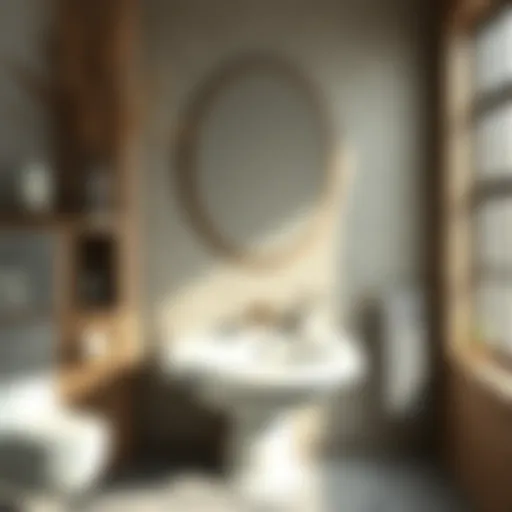Effective Soundproofing Strategies for Bedrooms

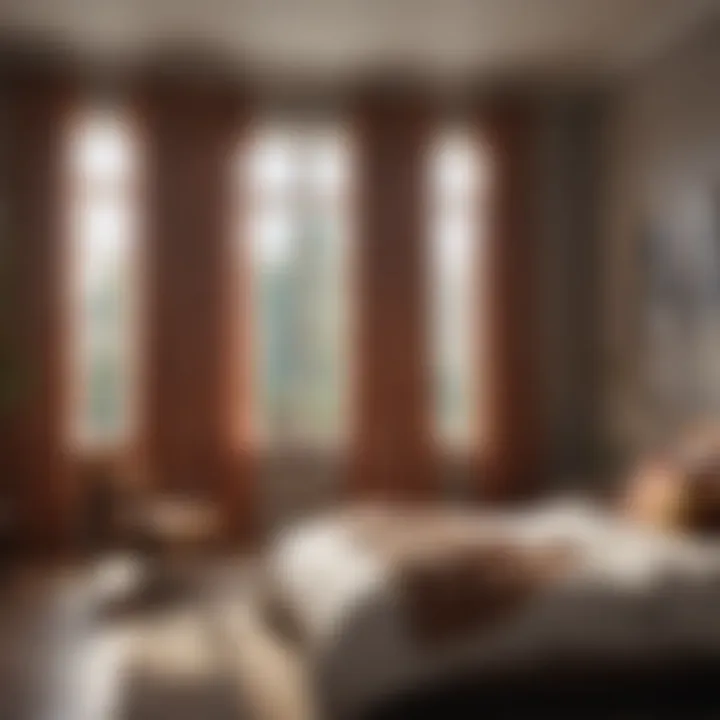
Intro
Soundproofing a bedroom is often an underappreciated yet crucial aspect of creating an ideal living environment. With the persistent hustle and bustle of urban life, many individuals find their sleep disrupted by unwanted external noise. This article serves as a practical guide, covering essential techniques and materials to help mitigate outside disturbances effectively. By taking appropriate measures, residents can significantly improve their sleep quality and overall well-being.
In this discussion, we will explore trending styles in soundproofing solutions, delve into color palettes that can contribute to a calming atmosphere, and provide detailed methodologies to achieve lasting results.
Understanding Sound and Noise Pollution
Noise pollution is a pervasive problem in many environments, and its implications can be significant, particularly in residential settings. In the context of this article, understanding noise pollution lays the groundwork for effective soundproofing practices. It is essential to recognize that not all sound is considered noise, which is a crucial first step in addressing the issue. Noise is often defined as unwanted or disruptive sound that can cause disturbances and affect quality of life.
Assessing noise levels in your surroundings provides insights into potential interventions.
Types of Noise and Their Sources
Noise can be categorized into various types, each stemming from different sources. The following list outlines common noise types and their origins:
- Traffic Noise: Often the most prevalent in urban areas, caused by vehicles, buses, and trains.
- Construction Noise: Includes sounds from building sites, machinery, and tools.
- Air Traffic Noise: Arises from aircraft flying overhead, especially near airports.
- Neighborhood Noise: Includes sounds from nearby homes, including voices, music, and pets.
Understanding these types of noise enables targeted soundproofing solutions. By identifying the main sources, homeowners can decide which strategies will be most effective in reducing noise infiltration.
Impact of Noise on Sleep Quality
Noise pollution profoundly affects sleep quality, leading to various health issues. Studies indicate that constant exposure to loud sounds can disrupt the sleep cycle, resulting in difficulty falling asleep and maintaining restful sleep. Symptoms may include fatigue, irritability, and a decrease in cognitive function. Furthermore, long-term exposure to noise may contribute to serious health problems such as hypertension and heart disease.
"Quality sleep is not merely a luxury; it is a foundation for overall health and well-being."
Incorporating soundproofing measures can lead to a notable improvement in sleep quality, allowing for deeper rest and recovery.
Why Soundproofing is Essential in Urban Living
Urban living frequently presents challenges related to noise exposure. As cities grow denser, the noise generated by various activities becomes intrusive. Inhabitants may find themselves navigating a constant barrage of sounds, leading to stress and discomfort. Soundproofing a bedroom becomes an essential strategy not only for preserving tranquility but also for maintaining mental health.
Investing in soundproofing solutions offers the benefit of a personal sanctuary amid urban chaos. Residents can reclaim their space, ensuring that external disturbances do not intrude on their home life. Ultimately, prioritizing soundproofing is not just about aesthetics; it is about enhancing overall comfort and well-being.
Evaluating Your Bedroom for Noise Infiltration
Understanding how noise enters your bedroom is a crucial step in effectively soundproofing the space. Assessing the level of noise infiltration provides homeowners with insights into the nature and source of disturbances that disrupt peace and sleep. Such evaluations allow a focused application of soundproofing techniques, ensuring that efforts are directed towards the most problematic areas.
When considering noise infiltration, it's essential to reflect on both the immediate environment and the structural characteristics of the home. By doing so, you can identify the most effective pathways through which noise travels. The benefits of this evaluation are manifold: not only can one prioritize renovations or changes to materials, but it also helps in understanding the acoustic landscape of the bedroom.
Identifying Problem Areas
The first step in evaluating your bedroom for noise infiltration is to identify specific problem areas. Start by paying attention to the type of noise that disrupts your peace. Common sources of outside noise include traffic, construction, and even neighboring activities. These sound sources can penetrate through various gaps and openings in your bedroom.
Look around your bedroom and observe different elements:
- Windows: Often, windows are weak points in sound barriers. Single-pane windows allow considerable noise to enter. Check for gaps around the frames.
- Doors: Same applies for doors; they can have significant gaps between them and the frame. Hollow-core doors offer little in terms of sound insulation.
- Walls: Bare walls may not provide adequate insulation; look for areas where walls meet, and check if any fixtures compromise soundproofing.
- Floors and Ceilings: Noise can travel through floors, especially in multi-story homes. Pay attention to shared walls as well.
Consider using an acoustic meter to capture more detailed measurements of noise levels in these areas. Once you clearly identify where the noise enters, making informed decisions about renovations and adjustments becomes much easier.
Conducting a Sound Test
After pinpointing the areas of concern, conducting a sound test is vital. This test involves measuring the level of noise in your bedroom under various conditions. Start by closing all doors and windows and observing the ambient noise level inside.
To perform a sound test effectively:
- Record the Noise Level: Using a sound level meter, take multiple readings during different times of the day. This helps capture peak noise levels during rush hours or other peak activities.
- Assess Variability: Noise levels can fluctuate; therefore, assessing noise over several days provides a comprehensive overview.
- Identify Peaks and Valleys: Notice the most disruptive times. Is it early morning, evening, or late at night? This information can inform your soundproofing strategy.
Conducting a thorough sound test reinforces your understanding of how to best soundproof your bedroom. It helps to ensure that your efforts result in a significant reduction of unwanted noise.
Soundproofing Techniques and Materials
Soundproofing is essential for anyone who seeks a peaceful bedroom away from the distractions of the outside world. Implementing the right techniques and materials can drastically enhance the acoustic quality of your sleeping environment. Various elements come into play, including the choice of material for insulation, the installation of soundproofing panels, and thoughtful layout planning. Understanding the significance of these solutions equips homeowners to create an ideal environment that fosters better sleep and improves overall well-being.
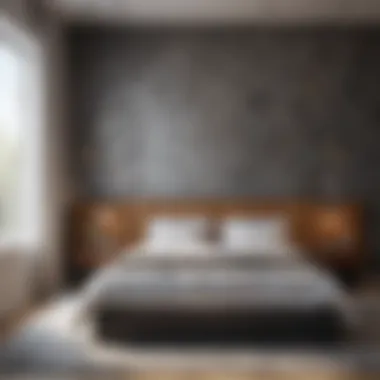
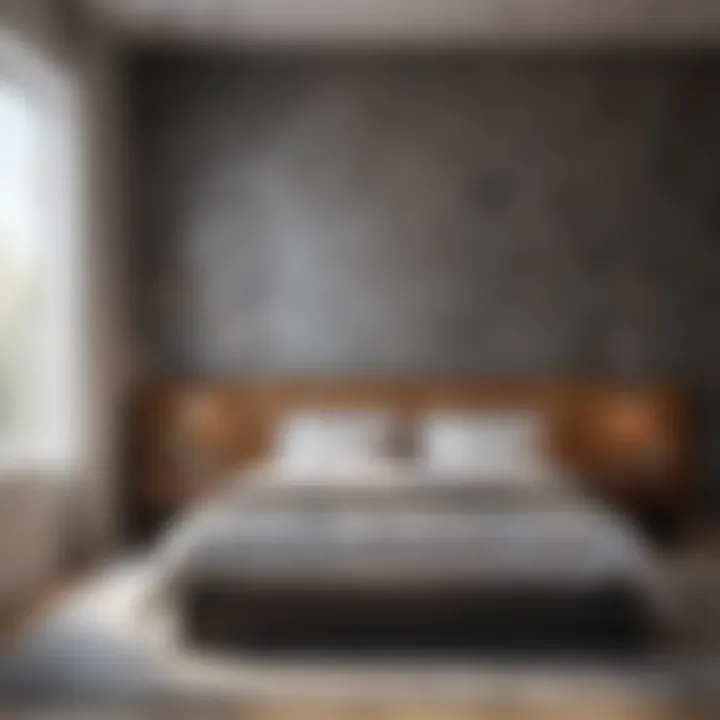
Acoustic Panels and Their Applications
Acoustic panels are a popular choice for soundproofing. They absorb sound waves and reduce echo, making them ideal for rooms with hard surfaces. These panels are generally made from foam, fabric, or fiberglass. When placed strategically on walls, they can minimize sound reflections caused by outside noise. This practice is particularly effective in urban settings where street noise is prevalent.
Installing acoustic panels can be done as a DIY project. They come in various designs and colors, allowing them to fit seamlessly into any bedroom decor. They can be used not only for soundproofing but also for aesthetic enhancement. When considering placement, focus on areas where sound is most likely to bounce, such as corners and spaces near windows.
Soundproofing Insulation Options
Insulation plays a pivotal role in soundproofing as it mitigates sound transmission between rooms. Various insulation materials exist, each with unique soundproofing properties. Some of the most effective options include mineral wool, fiberglass, and cellulose insulation. Mineral wool offers excellent sound absorption while also providing thermal insulation.
Another method involves using sound-rated insulation within wall cavities. This option is especially advantageous during renovations or new constructions. By incorporating soundproof insulation, the overall mood of the bedroom changes, creating a more tranquil and enjoyable space.
Flooring Solutions for Sound Absorption
Floors can often be a source of noise, especially in multi-story homes. Selecting the right flooring material can assist in sound dampening. Carpeting is one of the most effective choices, as the fibers absorb sound rather than reflecting it. Additionally, area rugs can also contribute to noise reduction.
For hard surface floors, consider the use of soundproof underlayment materials which can be installed under wood or laminate floors. These materials act as a buffer, diminishing sound impact and vibrations. Furthermore, keeping floors clear of clutter can help in maintaining a peaceful atmosphere by reducing noise from items moving around.
Door Seals and Acoustic Stripping
Doors are essential features in any soundproofing strategy. They are often overlooked sources of noise infiltration. The gaps around the door can allow significant sound passage, undermining other soundproofing efforts. Using weather stripping or acoustic door seals can effectively eliminate these gaps.
These solutions are simple to install and significantly improve the sound insulation of your bedroom. Ensure that the seals fit snugly, as even minor gaps can lead to substantial noise issues. Additionally, consider adding heavier solid-core doors, which tend to be denser and provide better sound blockage compared to hollow-core doors.
Important Note: Soundproofing a bedroom requires an integrated approach. Each technique enhances the overall effectiveness in creating a quiet environment.
By utilizing these soundproofing techniques and materials, one can develop a cohesive strategy aimed at protecting the serenity of the bedroom. This guide covers foundational steps for soundproofing, providing a path toward a more restful night's sleep.
Windows and Soundproofing
Windows play a significant role in how much outside noise infiltrates a bedroom. Poorly designed or old windows often allow sound to penetrate easily, disrupting the serenity you aim to create for a restful sleeping space. On the other hand, soundproof windows can mitigate noise intrusion, directly influencing sleep quality and overall well-being.
When considering soundproofing for your bedroom, it's essential to not only focus on the window types but also on additional treatments that can amplify their efficacy. Addressing the issue comprehensively results in a more peaceful environment, which ultimately supports your sleep health and daily productivity.
Choosing Soundproof Windows
Selecting the right soundproof windows is crucial in your soundproofing strategy. These windows typically feature double or triple glazing, which creates air gaps that significantly reduce noise transmission. The thicker the glass, the better the sound insulation. Consider these important factors:
- Window Frame Quality: Materials like vinyl or fiberglass tend to have better acoustic performance than aluminum.
- Sealing: Ensure that windows have proper seals to prevent any gaps that could allow noise to enter.
- Installation: Professional installation helps maintain integrity in the soundproofing.
Acoustic glass, designed specifically for noise reduction, is worth investigating if high levels of external noise are a concern. Acting as a barrier, it effectively lowers sound levels while still allowing natural light into your bedroom.
Window Treatments for Noise Reduction
Beyond selecting the right windows, various window treatments enhance soundproofing efforts. Consider the following options:
- Heavy Drapes: Thick, heavy curtains made from dense fabrics absorb sound. Look for materials such as velvet or blackout cloths.
- Acoustic Window Inserts: These are additional panes of glass placed over existing windows to add another layer of sound barrier.
- Blinds and Shades: Cellular shades, in particular, can trap air and minimize noise levels when closed.
Implementing these treatments can further reduce sound exposure and create a more tranquil bedroom atmosphere.
DIY Window Sealing Techniques
Soundproofing is not solely reliant on professional solutions. Many DIY techniques can improve your window's soundproofing effectiveness. Here are some practical methods:
- Weatherstripping: Use weatherstripping tape to seal gaps around the window frame, promoting a tighter fit to block out noise.
- Window Film: Installing sound-reducing window film can dampen sound vibrations while adding insulation benefits.
- Acoustic Caulk: Applying acoustic caulk in the seams can seal up any cracks or crevices that might allow sound to enter.
By engaging in these methods, it is possible to achieve noticeable improvement without substantial renovation costs. They stand as effective measures to enhance your bedroom's serenity.
"Investing time to improve window soundproofing can result in a notably quieter environment, fostering better sleep quality."
Furniture and Layout Considerations
When it comes to soundproofing a bedroom, the arrangement of furniture and the weight of those pieces plays a significant role. Effective layout strategies can create a buffer against unwanted noise, thereby enhancing the sleeping environment. Here, we dissect how the right furniture choices and an optimal layout can contribute to a quieter bedroom.
Utilizing Heavy Furniture for Noise Dampening
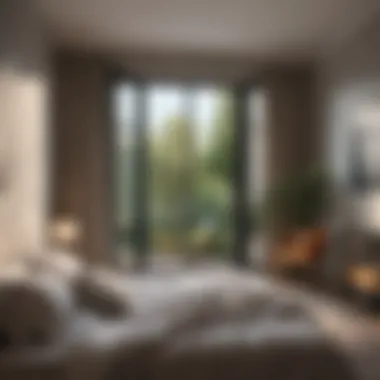
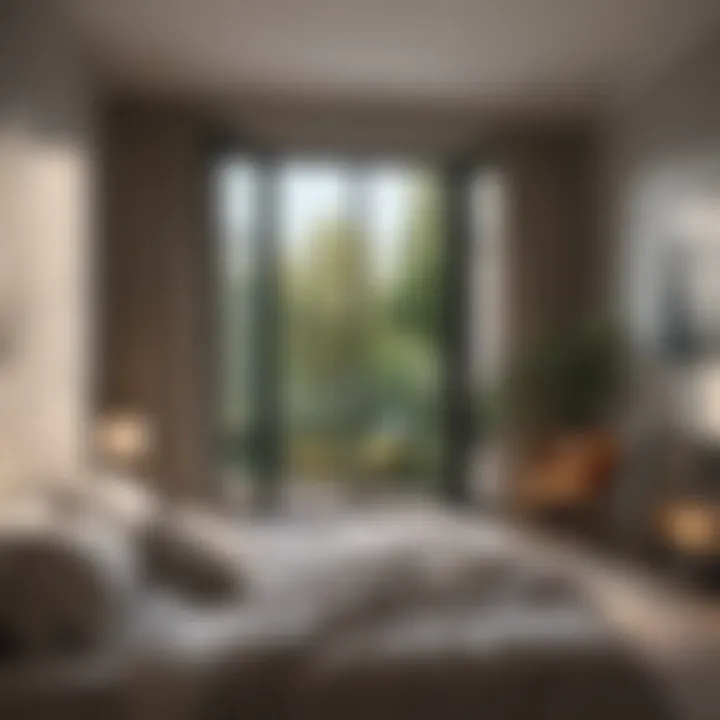
Heavy furniture can be an asset in the quest to reduce noise. Items such as bookcases, dressers, and large beds possess a natural density that can absorb sound waves. This is especially useful in urban settings where outside noise levels are high. By strategically placing heavier furniture against walls that face busy streets or noisy neighbors, you can create a barrier that helps muffle sound. For instance, a solid wood bookcase filled with books can serve a dual purpose: it enhances the room’s aesthetics while also dampening sound.
Tip: Consider positioning your bed against the wall that experiences the most external noise. This adds a layer of sound insulation that can aid in a peaceful sleep.
Another consideration is the use of rugs and carpets. Though not furniture, these textiles can bolster the soundproofing efforts when placed underneath heavy furniture. They absorb sound as well, creating a cocoon of quiet around your sleeping area.
Strategic Room Arrangement to Minimize Noise
The arrangement of furniture isn’t just about aesthetics; it is also about functionality and noise reduction. Start by identifying the sources of noise infiltration in the room. Once you know where the sound is coming from, you can make informed decisions about where to place your furniture.
For example, avoid placing your bed directly across from doors and windows, as these positions allow for sound to travel more freely. Instead, consider placing larger furniture pieces such as wardrobes or cabinets strategically in these areas to block incoming noise.
It’s also important to think about pathways within the room. High-traffic areas can create noise, so consider how movement through the space can affect the sound environment.
- Group furniture: Arrange seating and sleeping areas together. This minimizes overall room size that sound waves have to travel.
- Create a corner layout: Use corner placements for heavier items to take advantage of sound dampening while maximizing space usage.
In summary, combining heavy furniture and smart room arrangement can greatly impact the amount of noise that enters a bedroom. Thoughtful selection and placement lead to improved sound insulation and a more serene atmosphere to promote better sleep.
Incorporating Soundproofing into Renovations
Incorporating soundproofing measures during renovations is a crucial consideration for anyone aiming to enhance the serenity of their sleeping environment. Noise pollution can have significant impacts on health, especially in urban settings. Effective soundproofing techniques not only serve to improve the quality of sleep but also contribute to the overall comfort of your home.
When planning renovations, soundproofing should be a priority. It enables homeowners to create barriers against the disruptive noises from outside, leading to a peaceful retreat. This is particularly important in bedrooms since sleep is vital for overall well-being. Additionally, effective soundproofing can increase the value of a property, making it a worthwhile investment.
Planning for Soundproofing in New Builds
When constructing a new home, integrating soundproofing measures from the very beginning is beneficial. Here are some key elements to consider:
- Building Materials: Selecting sound-dampening building materials is crucial. Consider using resilient channels and soundproof drywall which can significantly reduce sound transfer.
- Design Layout: Position bedrooms away from high-noise areas such as streets. If possible, place non-noisy spaces, like bathrooms or closets, between the bedroom and the noise source.
- Flooring Choices: Use materials that absorb sound, such as carpet or padded laminate. These materials can minimize sound reflections within the room itself.
The benefits of planning for soundproofing in new builds extend beyond immediate comfort. A well-planned acoustic layout can lead to a quieter home, reducing stress and improving the quality of living.
Integrating Soundproofing during Renovations
If your space is already built, don’t worry; effective soundproofing is still achievable through thoughtful renovations. Here are some practical steps to incorporate soundproofing into existing structures:
- Upgrading Insulation: Replacing old insulation with high-density materials can block noise significantly. Look for products specifically designed for sound absorption, such as mineral wool or fiberglass insulation.
- Sealing Cracks and Gaps: Identify and seal cracks and gaps around windows, doors, and walls. Use caulk or acoustic sealant to prevent sound leakages.
- Acoustic Ceiling Tiles: If overhead noise is an issue, consider installing acoustic tiles. They can absorb sound waves and improve the room’s acoustics immediately.
- Heavy Drapes and Curtains: Adding heavy curtains can help dampen outside noise while also adding an element of style to the room.
"Soundproofing is not just about silence; it's about creating a conducive environment for rest and relaxation."
Integrating soundproofing during renovations is not just a functional choice but also a strategic investment in your home’s future. High-quality renovations lead to lasting benefits in comfort and peace for all household members. This approach to soundproofing helps transform your bedroom into a personal sanctuary, free from the disturbing influence of outside noise.
Final Touches for a Quiet Bedroom
Creating a quiet bedroom is about more than just implementing soundproofing materials and techniques. The final touches are essential to ensure that the space not only minimizes outside noise but also promotes comfort and tranquility. This section will cover the importance of careful selection of bedding and decor. By focusing on these elements, you can create an environment that is conducive to relaxation and restorative sleep.
Selecting Bedding for Optimal Comfort
The right bedding plays a critical role in your overall sleep quality. Choosing materials that enhance comfort and also provide a sense of coziness can help to create a serene sleep environment. Look for bedding made of natural fibers such as cotton or linen. These materials are breathable, helping to regulate temperature and wick moisture away, which is important for maintaining comfort through different seasons.
When selecting sheets, consider high thread count options. A higher thread count can create a smoother, softer feel against the skin. Additionally, blankets and comforters should provide both warmth and weight, contributing to a feeling of security as you rest.
Using heavier bedding can also have a secondary effect on sound reduction. Heavier fabrics may absorb more sound compared to lighter, thinner materials. This can further reduce the noise from outside, enhancing your bedroom's soundproofing.
Creating a Calming Atmosphere through Decor
The atmosphere of a bedroom can greatly influence how one feels in that space. Therefore, it is important to choose decor that promotes calmness and serenity. Opt for neutral colors as a choice for your walls and accessories. Soft hues, such as pale blue or beige, can have a calming effect, helping to reduce mental stress as you prepare to sleep.
Additionally, integrating soft lighting fixtures can contribute to a restful ambiance. Consider using dimmable lights or warm-colored bulbs for an inviting glow. Avoid bright white lights which may feel harsh and disrupt the relaxing environment you aim to create.
In terms of decor, consider adding soft elements like rugs or cushions. These can serve both aesthetic and functional purposes, as they help to dampen sound. Plants can also add to the ambiance while improving air quality. Just be mindful not to over-clutter your space; a clean, organized environment is often more calming.
By carefully selecting bedding and decor, you can significantly enhance the tranquility of your bedroom. These final touches not only contribute to the desired quiet but also create a sanctuary that feels conducive to relaxation and rest.
Maintenance and Long-Term Considerations

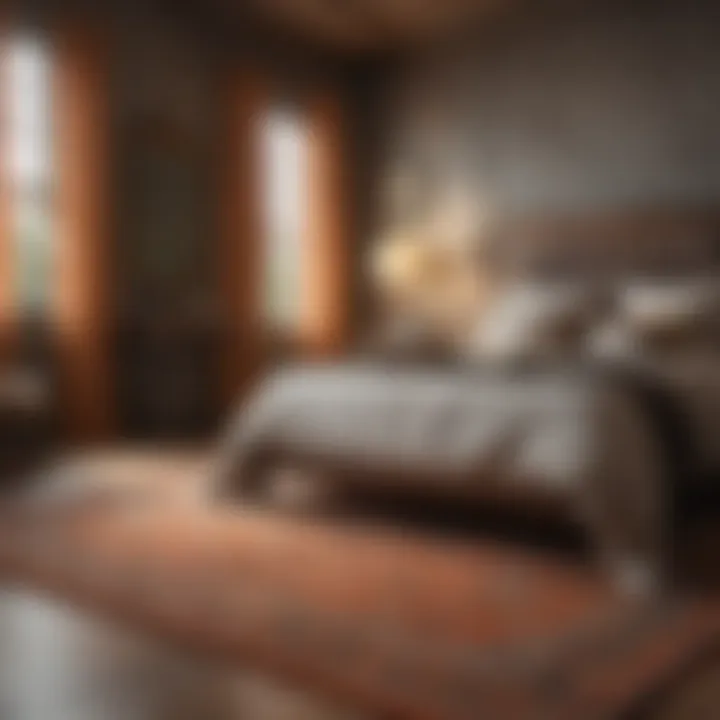
Maintaining soundproofing measures in a bedroom is essential for ensuring the continued effectiveness of noise reduction techniques. Over time, materials can degrade or become less effective. Regular maintenance can extend the life of your soundproofing installations and keep your space quiet.
Homeowners should understand that soundproofing is not a one-time task. Factors such as weather, wear and tear, and even changes in living habits can affect how effective soundproofing remains. For this reason, it is important to have a plan to regularly assess and maintain soundproofing solutions.
Regular Inspections for Soundproofing Integrity
Inspections play a crucial role in identifying potential issues before they become serious problems. Regular checks can help determine whether soundproofing measures are still functioning correctly. You should focus on areas like windows, doors, and walls. Look for gaps, cracks, or wear in seals and insulation.
Conducting inspections every few months can provide a clear understanding of your soundproofing integrity. Make a checklist to systematically evaluate each component:
- Windows: Check for any visible cracks or gaps. Ensure seals around windows are intact.
- Doors: Ensure that door sweeps and seals are in good condition.
- Walls and Ceilings: Look for any shifts or signs of damage that could allow noise infiltration.
If any component seems compromised, addressing it promptly can prevent more significant issues down the line.
Updating Materials for Continued Effectiveness
Updating soundproofing materials is another vital aspect of maintaining a quiet bedroom. Over time, materials can lose their effectiveness or even become outdated. Options may be limited if you still rely on older products. Consider modern advancements in soundproofing materials, which may offer better performance.
Here are key areas to consider for updates:
- Insulation: Check if the insulation used in walls or ceilings is still adequate. New types of insulation, like mineral wool, can provide better sound absorption.
- Acoustic Panels: If the panels have absorbed too much moisture or have become damaged, replacement is necessary to maintain their effectiveness.
- Seals and Stripping: Weather stripping around doors and windows can wear out. Replace it regularly to maintain a tight seal against noise.
By committing to regular inspections and updates, homeowners can ensure that their soundproofing efforts remain effective over time.
"Investing time in maintenance sustains the benefits of soundproofing, ensuring lasting peace and reduced noise distraction."
Ensuring a quiet bedroom is a continuous process that requires careful attention. A proactive approach to maintenance and updates will ultimately result in a better living environment, allowing for improved sleep quality and overall well-being.
Professional Options for Soundproofing
Soundproofing a bedroom is not just about applying do-it-yourself methods, but also about understanding when to seek professional assistance. In urban environments, where noise pollution is common, the impact on sleep and overall well-being can be profound. Professional options for soundproofing offer solutions that may not be easily achievable through individual efforts. These services often utilize advanced techniques and high-quality materials that ensure maximum noise reduction.
Engaging professional services can significantly enhance the effectiveness of soundproofing measures. For instance, professionals can identify subtle sound infiltration sources that may not be apparent to a homeowner. Their expertise allows for tailored solutions that align with the specific acoustic needs of each home. Additionally, professionals often have access to better technologies and materials, which can result in superior outcomes.
"Selecting the right professional service can transform your sleeping environment, providing the peaceful retreat you deserve."
When considering professional options, understanding the full scope of services available can help in making informed decisions. Beyond simple installations, professional soundproofing may include structural modifications, specialized soundproofing products, and strategic assessments of existing layouts that contribute to noise transmission.
Evaluating the Need for Professional Help
Before deciding to hire a professional for soundproofing, it is important to evaluate the specific needs of your bedroom. Assess the level of noise infiltration and determine if existing measures are effective. Homeowners should consider the following factors:
- Type of noise: Identify if the noise source is airborne (like traffic or voices) or impact noise (like footsteps or music).
- Duration and intensity: Evaluate how often and how loud this noise is during the night.
- Personal comfort level: Determine if the noise is affecting sleep quality and general well-being.
If the noise is significant and affects comfort, professional help should be considered. Professionals can offer a thorough assessment and suggest the most effective solutions tailored to your situation. For those who may not have experience in soundproofing, the investment in expertise can save time and enhance outcomes.
Selecting the Right Soundproofing Contractor
Choosing the right contractor for soundproofing is crucial. Look for contractors specializing in acoustic treatments and soundproofing. Here are some recommendations to help narrow down options:
- Experience and Reputation: Research contractors who have a strong track record in soundproofing projects. Reviews from previous clients can be helpful in selecting a reputable professional.
- Certifications: Ensure that the contractors are certified and knowledgeable about building codes and soundproofing principles.
- Customized Solutions: A good contractor should be willing to provide tailored solutions that meet your specific needs rather than offering one-size-fits-all options.
- Material Knowledge: They should be informed about various soundproofing materials and technologies available in the market to ensure the best results.
- Cost Transparency: Request detailed quotes and ensure there are no hidden fees. A clear understanding of costs can help in making informed decisions.
By taking these steps, homeowners can select a contractor who not only provides quality work but also prioritizes customer satisfaction. Properly implemented soundproofing by skilled professionals can create a bedroom that is restful and serene, enhancing sleep quality and overall health.
Epilogue
In today's world, sound pollution has become a significant issue, particularly in urban settings. Creating a peaceful sleeping environment is more important than ever. This article has outlined essential techniques and materials for soundproofing a bedroom effectively. The importance of this topic extends beyond merely blocking noise. It encompasses improved mental well-being, better sleep quality, and ultimately a healthier lifestyle.
Recap of Key Soundproofing Strategies
To summarize the key strategies discussed:
- Assess the space: Understanding where noise enters is the first step.
- Use Acoustic Panels: These can treat sound reflections and absorb noise.
- Insulation Options: Invest in soundproof insulation.
- Upgrade Windows: Consider soundproof windows or add suitable window treatments.
- Evaluate Doors: Install soundproof door seals to minimize leakage.
By applying these strategies, one can significantly reduce unwanted noise. It provides a tangible path toward achieving tranquility.
Future Trends in Bedroom Soundproofing
As technology advances, the future of soundproofing looks promising. Innovations like smart materials that adapt to their environment are on the horizon. These materials offer dynamic solutions to noise control, becoming increasingly important in modern architecture.
- Green Soundproofing: Many homeowners will prefer environmentally friendly options.
- Integration of Technology: Soundproofing solutions that incorporate smart technology for ease of use.
- Customization: Tailored solutions based on individual residences and specific noise challenges.













